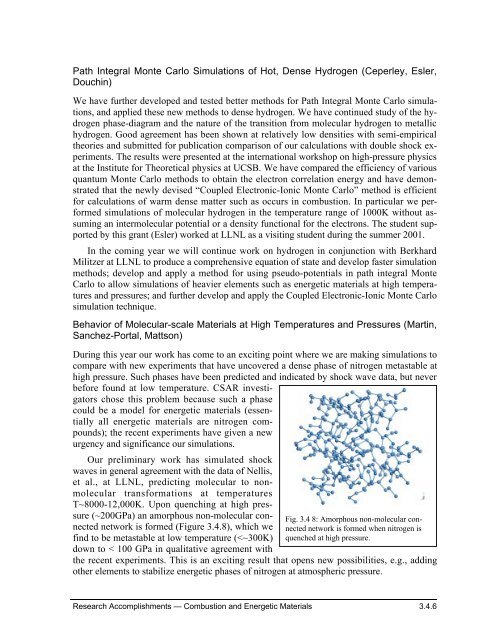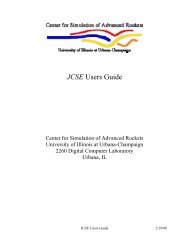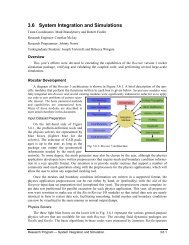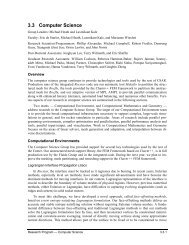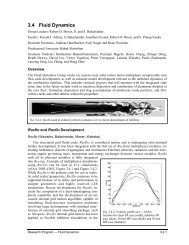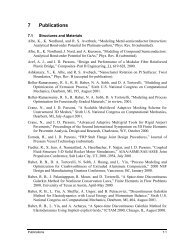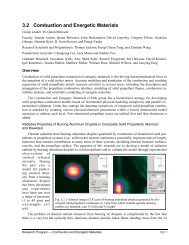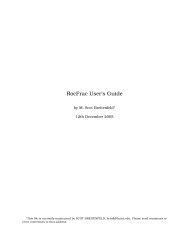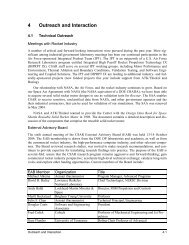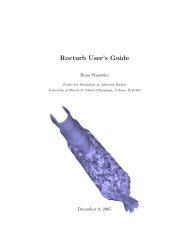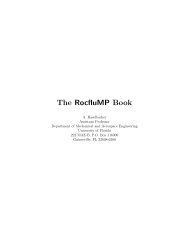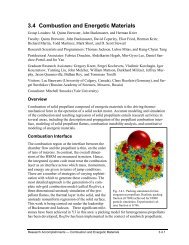3.4 Combustion and Energetic Materials
3.4 Combustion and Energetic Materials
3.4 Combustion and Energetic Materials
Create successful ePaper yourself
Turn your PDF publications into a flip-book with our unique Google optimized e-Paper software.
Path Integral Monte Carlo Simulations of Hot, Dense Hydrogen (Ceperley, Esler,<br />
Douchin)<br />
We have further developed <strong>and</strong> tested better methods for Path Integral Monte Carlo simulations,<br />
<strong>and</strong> applied these new methods to dense hydrogen. We have continued study of the hydrogen<br />
phase-diagram <strong>and</strong> the nature of the transition from molecular hydrogen to metallic<br />
hydrogen. Good agreement has been shown at relatively low densities with semi-empirical<br />
theories <strong>and</strong> submitted for publication comparison of our calculations with double shock experiments.<br />
The results were presented at the international workshop on high-pressure physics<br />
at the Institute for Theoretical physics at UCSB. We have compared the efficiency of various<br />
quantum Monte Carlo methods to obtain the electron correlation energy <strong>and</strong> have demonstrated<br />
that the newly devised ÒCoupled Electronic-Ionic Monte CarloÓ method is efficient<br />
for calculations of warm dense matter such as occurs in combustion. In particular we performed<br />
simulations of molecular hydrogen in the temperature range of 1000K without assuming<br />
an intermolecular potential or a density functional for the electrons. The student supported<br />
by this grant (Esler) worked at LLNL as a visiting student during the summer 2001.<br />
In the coming year we will continue work on hydrogen in conjunction with Berkhard<br />
Militzer at LLNL to produce a comprehensive equation of state <strong>and</strong> develop faster simulation<br />
methods; develop <strong>and</strong> apply a method for using pseudo-potentials in path integral Monte<br />
Carlo to allow simulations of heavier elements such as energetic materials at high temperatures<br />
<strong>and</strong> pressures; <strong>and</strong> further develop <strong>and</strong> apply the Coupled Electronic-Ionic Monte Carlo<br />
simulation technique.<br />
Behavior of Molecular-scale <strong>Materials</strong> at High Temperatures <strong>and</strong> Pressures (Martin,<br />
Sanchez-Portal, Mattson)<br />
During this year our work has come to an exciting point where we are making simulations to<br />
compare with new experiments that have uncovered a dense phase of nitrogen metastable at<br />
high pressure. Such phases have been predicted <strong>and</strong> indicated by shock wave data, but never<br />
before found at low temperature. CSAR investigators<br />
chose this problem because such a phase<br />
could be a model for energetic materials (essentially<br />
all energetic materials are nitrogen compounds);<br />
the recent experiments have given a new<br />
urgency <strong>and</strong> significance our simulations.<br />
Our preliminary work has simulated shock<br />
waves in general agreement with the data of Nellis,<br />
et al., at LLNL, predicting molecular to nonmolecular<br />
transformations at temperatures<br />
T~8000-12,000K. Upon quenching at high pressure<br />
(~200GPa) an amorphous non-molecular connected<br />
network is formed (Figure <strong>3.4</strong>.8), which we<br />
find to be metastable at low temperature (


